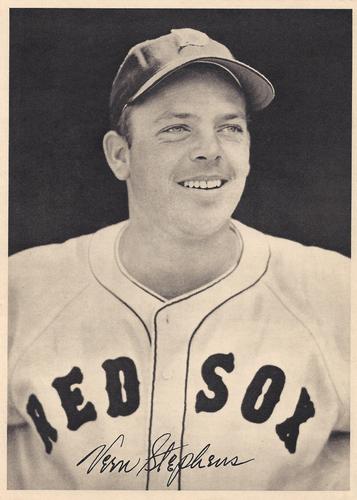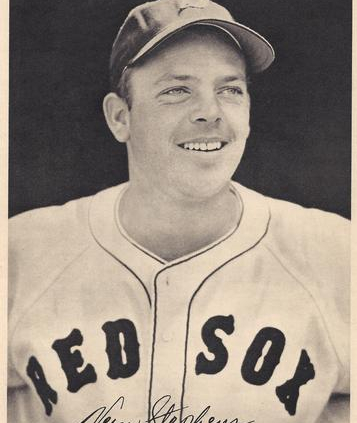August 27, 1949: Ted Williams and Vern Stephens vie for home run crown as Red Sox beat White Sox
 The 1949 season was nearing the end of August. The Chicago White Sox and Boston Red Sox both had 122 games in the books, entering play on August 27. The American League standings showed Chicago in sixth place (51-71), 15 games behind the fourth-place Philadelphia Athletics and nearly 10 ahead of the seventh-place St. Louis Browns.
The 1949 season was nearing the end of August. The Chicago White Sox and Boston Red Sox both had 122 games in the books, entering play on August 27. The American League standings showed Chicago in sixth place (51-71), 15 games behind the fourth-place Philadelphia Athletics and nearly 10 ahead of the seventh-place St. Louis Browns.
The 74-48 Red Sox, though, were in the thick of a pennant fight, just 1½ games behind the first-place New York Yankees. They were on their fourth visit of the season to Chicago. They had swept a doubleheader from the White Sox the day before, 11-4 and 10-7. The Red Sox had won 15 of the 20 matchups between the two ballclubs.
This Saturday afternoon game drew just over 10,000 to Comiskey Park. The opposing starters were left-hander (and 20-year-old bonus baby) Chuck Stobbs for the Red Sox and 24-year old righty Howie Judson for the White Sox.
The only baserunner for Boston in the first inning was Johnny Pesky; the third baseman drew a walk. Chicago’s first baseman, Steve “Bud” Souchock, tripled with one out in the bottom of the first. Shortstop Luke Appling followed him and hit a fly ball to Al Zarllla in right field. Souchock tagged up to score, but Zarilla’s throw to Birdie Tebbetts at the plate got there in time for a double play. The game remained scoreless after an inning.
Zarilla, like Pesky, drew a one-out walk in the top of the second. Like Pesky, he was left stranded. Stobbs retired the three Chicago batters in order in the bottom of the second.
With one out in the top of the third, center fielder Dom DiMaggio singled for the Red Sox. Pesky drew another walk. But Ted Williams – who had hit two homers and driven in four runs the day before – grounded into a 4-6-3 double play. Once again Stobbs retired the side in order in the bottom of the inning.
The Red Sox got two walks in the top of the fourth, but no runs. Chicago got on the scoreboard in its half. With one out, Souchock singled. Appling fouled out to Billy Goodman at first base for the second out. Second baseman Cass Michaels hit a “slow roller” that Stobbs fielded.
But the young Red Sox pitcher threw wildly to Goodman and the ball went “far down into right-field foul territory.”1 Goodman ran to retrieve it, and – seeing Souchock motoring around third base – threw home. It was a close play, but home-plate umpire Red Jones called Souchock safe. Tebbetts “protested violently … bumping the arbiter with his chest.”2 He was, of course, immediately ejected. The White Sox led, 1-0.
Judson had given up just one single over the first four innings. Edward Burns of the Chicago Tribune wrote that Judson “has considerable stuff, but his career is being handicapped by the fact he invariably loses it after four innings of sharp pitching.”3 This trend continued on this afternoon at Comiskey Park.
DiMaggio singled with one out in the top of the fifth. With two outs, DiMaggio had progressed to second base. Williams came to bat with first base open.
One might have anticipated an intentional walk; at this point in his career, Williams had already surpassed 1,000 bases on balls, a healthy number of them intentional. That was not the call from White Sox manager Jack Onslow. Judson was to pitch to Williams.
The Red Sox left fielder hit a two-run homer to right field, his 33rd home run of the season, “a 400-foot shot to the stands in deep right center.”4 That gave the Red Sox a 2-1 lead.
Shortstop Vern “Junior” Stephens was up next. He also had 33 home runs so far in 1949. He hit one, too, into the upper deck in left-center. It was number 34, Stephens reestablishing his one-homer edge. The two homers gave Boston a 3-1 lead.
Stobbs had another three-up, three-down inning in the fifth.
The Red Sox added a fourth run in top of the sixth, on back-to-back leadoff singles by Zarilla and Goodman. Zarilla ran first to third on Goodman’s hit, and scored moments later on a sacrifice fly by Matt Batts, who had replaced Tebbetts as the catcher after the ejection.
The White Sox also added a run in their half of the sixth. They too led off with back-to-back singles, by right fielder Dave Philley and – with his third hit of the game – Souchock. Appling grounded into a force out at second base, but Cass Michaels singled, scoring Philley. A double play ended the inning with Boston ahead, 4-2.
Ted Williams led off the seventh for Boston, grounding out to first base, unassisted. Vern Stephens hit a 400-foot triple to right field that might have gone for an inside-the-park home run, but the ball bounced up and hit the wall and caromed back. Bobby Doerr and Zarilla both drew walks, and the bases were loaded. Goodman hit the ball back to Judson, though, who threw home to get Stephens at the plate, and Batts hit the ball to Judson, too. This time, Judson threw to first base for the third out.
Stobbs retired the three batters he faced in the bottom of the seventh. Both starters were still in the game.
In the top of the eighth, Stobbs singled. After DiMaggio popped up, Pesky singled, putting two runners on for Ted Williams.
This time, Williams hit a three-run homer. “It went on a bee line into the lower right center tier.”5 It was the second day in a row he’d hit two homers in a game. This one gave him a total of five RBIs in the game; Boston led, 7-2. He and Stephens were tied with 34 homers apiece. Even with Williams’s five RBIs, Stephens retained his lead in that department, 139-132.
In the bottom of the eighth, Gus Zernial pinch-hit for Judson. Jack Onslow was hoping to get something started. Nothing doing; Stobbs struck out the slugger. Philley grounded out, short to first, and Souchock flied out to right.
Ed Klieman worked the mound for the White Sox in the ninth inning. Every one of the three Boston batters hit the ball to Appling at short; he collected two putouts and an assist.
Michaels walked with one out in the bottom of the ninth, but no other White Sox batter reached base. Stobbs closed out the win, boosting his record to 9-4.
Judson was having a dismal 1949; this loss dropped him to 1-14. He’d won his first start, back on April 21 in Detroit, but then dropped 14 consecutive decisions. He appeared in six more games, all in relief, before the season was done but without either a win or another loss.
Stobbs ended his season 11-6, with a 4.03 ERA. Judson’s ERA was 4.50, not that dramatically different, but he was pitching for a team that didn’t have as much going for it.
The Red Sox lost the AL pennant on the final day of the season. Ted Williams led the league in home runs (43 – Stephens had 39) and RBIs (159 – tied with Stephens), as well as on-base percentage (.490). He was voted AL MVP, but there was no postseason play.
Acknowledgments
This article was fact-checked by Thomas E. Merrick and copy-edited by Len Levin.
Sources
In addition to the sources cited in the Notes, the author consulted Baseball-Reference.com and Retrosheet.org.
https://www.baseball-reference.com/boxes/CHA/CHA194908270.shtml
https://www.retrosheet.org/boxesetc/1949/B08270CHA1949.htm
Photo credit: Vern Stephens, Trading Card Database.
Notes
1 Arthur Sampson, “Williams Drives in Five; Stephens Also Connects as Stobbs Checks Chisox,” Boston Herald, August 28, 1948: 81.
2 Jack Barry, “Red Sox Win, 7-2; Yankees 4-0,” Boston Globe, August 28, 1949: C1.
3 Edward Burns, “2 Homers by Ted Williams Rout Sox, 7-2,” Chicago Tribune, August 28, 1949: A1.
4 Burns. Arthur Sampson said the ball went 15 rows deep into the stands.
5 Barry.
Additional Stats
Boston Red Sox 7
Chicago White Sox 2
Comiskey Park
Chicago, IL
Box Score + PBP:
Corrections? Additions?
If you can help us improve this game story, contact us.


